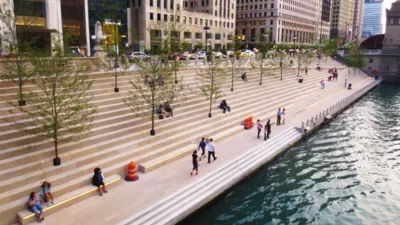As a part of Chicago's $1.4 billion "Plan for Transformation," the once massive Cabrini-Green project has been redeveloped into a mix of affordable, public and market housing. But 80% of the former tenants have moved away.
"Cabrini-Green is Chicago's best-known housing project, and was the first to see the wrecking ball. At its height, Cabrini was home to 15,000 residents spread over 15 red-brick high-rises (the "Reds"), eight 16-story towers (the "Whites"), and a patch of street-level row houses. The row houses, built in 1942, were originally home to Italian immigrants; 15 years later, the high-rises began to go up to accommodate the growing number of Southern blacks moving to Chicago. Before long, Cabrini-Green became a segregated black ghetto with a reputation for crime, poverty, and urban decay.
By 2000, the Chicago Housing Authority was entrusted with a $1.4 billion budget to overhaul its public housing, with much of the initial funding coming from the Department of Housing and Urban Development. Finally, after decades of neglect and agency corruption, the CHA-which had been taken over for a time by HUD-would begin dismantling its public housing system in a strategy called the Plan for Transformation or, more simply, the Plan.
The Plan was originally scheduled for completion next year, but the deadline has been extended to 2015, due in part to tenant litigation and the drying up of federal funds. When it's done, 25,000 public-housing units will have been razed or rehabilitated across the city. The impact of the Plan on the city's landscape is already unmistakable. Cabrini-Green, once a massive cluster of high-rises and row houses just a 10-minute walk from the elegant stores of Michigan Avenue, is mostly gone. A handful of buildings remain, surrounded on all sides by new condominiums and booming retail stores. Twenty percent of these condos have been set aside as affordable housing; a third will be public housing. The rest are selling for up to $850,000 a piece. Since the Plan launched, in 2000, more than $2 billion in residential property has been sold within two blocks of Cabrini.
When the Plan came to Cabrini, all lease-abiding residents were given a legal "right to return" to a new apartment on-site, but those who didn't want to wait years for a new home, or who feared they wouldn't qualify, could take a rent subsidy voucher, called a Section 8, and live elsewhere. More than 80 percent of the tenants who opted for this voucher have moved to areas of Chicago more segregated, isolated, and poor than Cabrini had been.
Miami announced recently that it will pursue a similar strategy, joining other American cities already following Chicago's lead. What this will mean for the country's urban poor is not yet known-whether plans like this will deliver their promise of safe, improved shelter, or merely serve as city-sponsored gentrification schemes, reducing the amount of safe housing available to the country's neediest people. Public-housing advocates express concern about the implementation of such a national-scale strategy before the real human costs can be measured."
FULL STORY: Two Tales of One City

Study: Maui’s Plan to Convert Vacation Rentals to Long-Term Housing Could Cause Nearly $1 Billion Economic Loss
The plan would reduce visitor accommodation by 25,% resulting in 1,900 jobs lost.

North Texas Transit Leaders Tout Benefits of TOD for Growing Region
At a summit focused on transit-oriented development, policymakers discussed how North Texas’ expanded light rail system can serve as a tool for economic growth.

Why Should We Subsidize Public Transportation?
Many public transit agencies face financial stress due to rising costs, declining fare revenue, and declining subsidies. Transit advocates must provide a strong business case for increasing public transit funding.

How Community Science Connects People, Parks, and Biodiversity
Community science engages people of all backgrounds in documenting local biodiversity, strengthening connections to nature, and contributing to global efforts like the City Nature Challenge to build a more inclusive and resilient future.

Alabama: Trump Terminates Settlements for Black Communities Harmed By Raw Sewage
Trump deemed the landmark civil rights agreement “illegal DEI and environmental justice policy.”

Dear Tesla Driver: “It’s not You, It’s Him.”
Amidst a booming bumper sticker industry, one writer offers solace to those asking, “Does this car make me look fascist?”
Urban Design for Planners 1: Software Tools
This six-course series explores essential urban design concepts using open source software and equips planners with the tools they need to participate fully in the urban design process.
Planning for Universal Design
Learn the tools for implementing Universal Design in planning regulations.
City of Santa Clarita
Ascent Environmental
Institute for Housing and Urban Development Studies (IHS)
City of Grandview
Harvard GSD Executive Education
Toledo-Lucas County Plan Commissions
Salt Lake City
NYU Wagner Graduate School of Public Service





























